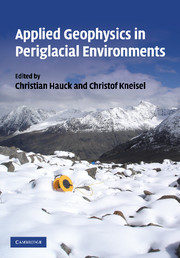Book contents
- Frontmatter
- Contents
- List of contributors
- Introduction
- Part I Geophysical methods
- Part II Case studies
- 5 Typology of vertical electrical soundings for permafrost/ground ice investigation in the forefields of small alpine glaciers
- 6 ERT imaging for frozen ground detection
- 7 Electrical resistivity values of frozen soil from VES and TEM field observations and laboratory experiments
- 8 Results of geophysical surveys on Kasprowy Wierch, the Tatra Mountains, Poland
- 9 Reassessment of DC resistivity in rock glaciers by comparing with P-wave velocity: a case study in the Swiss Alps
- 10 Quantifying the ice content in low-altitude scree slopes using geophysical methods
- 11 The use of GPR in determining talus thickness and talus structure
- 12 GPR soundings of rock glaciers on Svalbard
- 13 Arctic glaciers and ground-penetrating radar. Case study: Stagnation Glacier, Bylot Island, Canada
- 14 Mapping of subglacial topography using GPR for determining subglacial hydraulic conditions
- 15 Snow measurements using GPR: example from Amundsenisen, Svalbard
- 16 Mapping frazil ice conditions in rivers using ground penetrating radar
- Appendix: Tables of geophysical parameters for periglacial environments
- Index
- Plate section
- References
9 - Reassessment of DC resistivity in rock glaciers by comparing with P-wave velocity: a case study in the Swiss Alps
Published online by Cambridge University Press: 22 August 2009
- Frontmatter
- Contents
- List of contributors
- Introduction
- Part I Geophysical methods
- Part II Case studies
- 5 Typology of vertical electrical soundings for permafrost/ground ice investigation in the forefields of small alpine glaciers
- 6 ERT imaging for frozen ground detection
- 7 Electrical resistivity values of frozen soil from VES and TEM field observations and laboratory experiments
- 8 Results of geophysical surveys on Kasprowy Wierch, the Tatra Mountains, Poland
- 9 Reassessment of DC resistivity in rock glaciers by comparing with P-wave velocity: a case study in the Swiss Alps
- 10 Quantifying the ice content in low-altitude scree slopes using geophysical methods
- 11 The use of GPR in determining talus thickness and talus structure
- 12 GPR soundings of rock glaciers on Svalbard
- 13 Arctic glaciers and ground-penetrating radar. Case study: Stagnation Glacier, Bylot Island, Canada
- 14 Mapping of subglacial topography using GPR for determining subglacial hydraulic conditions
- 15 Snow measurements using GPR: example from Amundsenisen, Svalbard
- 16 Mapping frazil ice conditions in rivers using ground penetrating radar
- Appendix: Tables of geophysical parameters for periglacial environments
- Index
- Plate section
- References
Summary
Introduction
Vertical electrical resistivity soundings (VES) have been extensively used to investigate the internal structure of rock glaciers (e.g. Fisch et al. 1977, King et al. 1987, Ikeda and Matsuoka 2002). In particular, two-dimensional (2D) electrical resistivity tomography (ERT) has recently revealed the internal structure in greater detail (e.g. Vonder Mühll et al. 2000, Ishikawa et al. 2001, Ikeda and Matsuoka 2006, see also Chapters 1 and 6). Hauck and Vonder Mühll (2003), however, argued that even such tomographical methods include ambiguity in the model inversion and interpretation of DC resistivity. Although combining different geophysical properties reduces ambiguity in the interpretation of a single geophysical property (Haeberli 1985, Hauck and Vonder Mühll 2003), many studies have relied on DC resistivity methods alone. Thus, interpretation of DC resistivity in rock glaciers and related terrain requires further assessment.
This study compares DC resistivity with P-wave velocity in a number of rock glaciers. DC resistivities and/or P-wave velocities were measured on 26 talus-derived rock glaciers lying near the lower limit of mountain permafrost in the Upper Engadin, Swiss Alps. Both one-dimensional (1D) VES and 2D ERT surveys were performed at seven sites. Special attention was given to the effects of spatial variations in lithological and thermal conditions. The results were compiled for three types of rock glaciers:
(i) bouldery rock glaciers having an active layer composed of matrix-free boulders,
(ii) pebbly rock glaciers consisting of matrix-supported pebbles and cobbles, and
(iii) (densely) vegetated rock glaciers that mostly represent relict (bouldery) rock glaciers (see Ikeda and Matsuoka 2002, 2006 for the classification).
- Type
- Chapter
- Information
- Applied Geophysics in Periglacial Environments , pp. 137 - 152Publisher: Cambridge University PressPrint publication year: 2008
References
- 1
- Cited by



